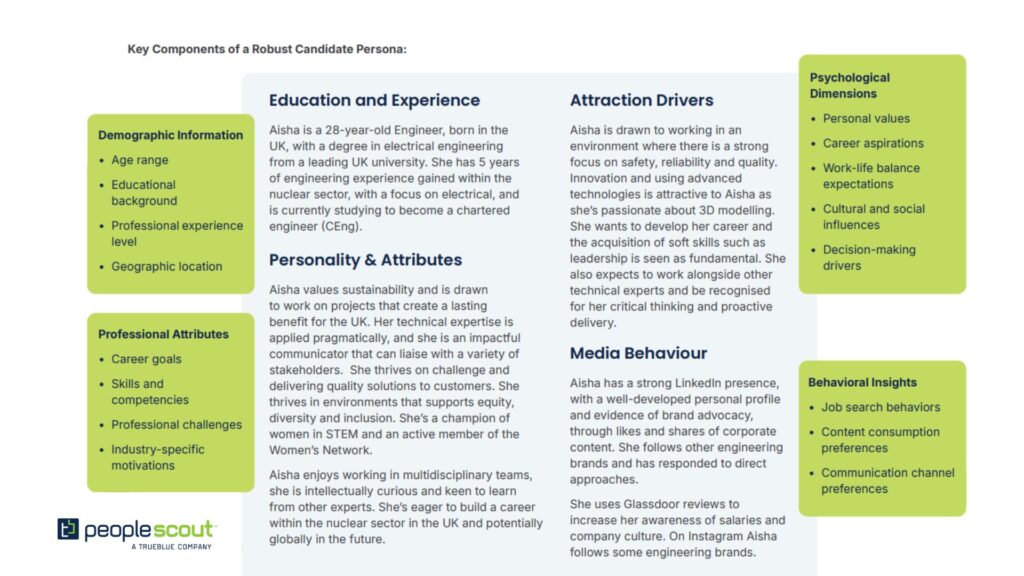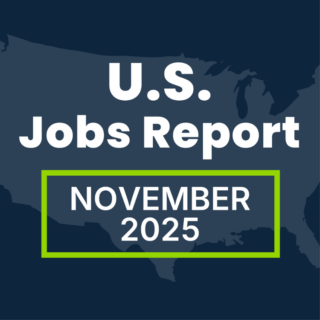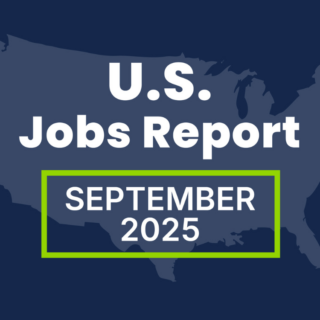The best talent isn’t actively job hunting—they’re being courted, engaged and strategically attracted by organizations that understand exactly who they are and what motivates them. This is where candidate personas become your recruitment superpower.
Just as marketing teams have long used buyer personas to craft targeted campaigns that resonate with specific customer segments, forward-thinking talent acquisition teams are leveraging candidate personas to cut through the noise and connect authentically with their ideal hires.
What are Candidate Personas?
A candidate persona is more than a simple job description or a list of qualifications. It’s a comprehensive profile that captures the essence of your ideal candidate—encompassing their professional aspirations, personal motivations, behavioral patterns and unique characteristics.
It’s important to remember that candidate personas are not a specific recipe for talent, behaviors, interests or skills. They are an indicative representation of what your desired talent will have and how they might present or engage with recruitment marketing campaigns. They act as a helpful guide for where and how to identify the talent you’re looking to attract.
Personas are also often referred to as tribes. This indicates a more inclusive approach and can help dispel the assumption that personas are a target list of exclusive and needed characteristics.
Key Components of a Robust Candidate Persona:

Demographic Information
- Age range
- Educational background
- Professional experience level
- Geographic location
Professional Attributes
- Career goals
- Skills and competencies
- Professional challenges
- Industry-specific motivations
Behavioral Insights
- Job search behaviors
- Content consumption preferences
- Communication channel preferences
Psychological Dimensions
- Personal values
- Career aspirations
- Work-life balance expectations
- Cultural and social influences
- Decision-making drivers
Building Your Candidate Persona Profiles
Step 1: Data Collection and Research
The foundation of an effective candidate persona is rigorous, multi-source research. Your goal is to create personas grounded in real insights, not assumptions.
Data Collection Methods:
- Interviews with current high-performing employees
- Exit interviews with departing staff
- Recruitment and performance data analysis
- Hiring manager insights
- Candidate feedback surveys
- Industry benchmarking reports
💡 Pro Tip: Prioritize data from successful employees who have thrived in similar roles within your organization. They offer the most relevant insights.
Step 2: Trend Identification and Analysis
Once you’ve gathered data, the next step is identifying shared characteristics and trends. This is where your personas begin to take shape.
Guiding Questions for Analysis:
- What common motivational patterns emerge?
- What career progression paths do top performers typically follow?
- What skills consistently predict success in this role?
- What challenges do candidates in this field typically face?
Step 3: Persona Development and Refinement
Now it’s time to transform your research into living, breathing personas. Focus on creating personas that are research-driven and free from unconscious bias.
Persona Creation Best Practices:
- Use anonymized, aggregated data
- Focus on professional and behavioral attributes
- Avoid stereotyping
- Regularly update personas based on new insights
Capturing Nuances in Persona Mapping
In a globalized talent market, candidate personas must transcend cultural boundaries while respecting local nuances. A software engineer in America will have different motivations than one in India, and your personas should reflect that.
Key Considerations:
- Professional expectations vary across cultures
- Communication styles differ globally
- Career progression models are not universal
- Work-life balance concepts are culturally influenced
Beyond regional difference, you also need to consider other ways your personas could be influenced, including:

Applying Candidate Personas to Your Marketing Content
Now that you’ve got your personas created, here are some ways you can leverage them to personalize messaging across your talent segments:
Channel-Specific Messaging
- LinkedIn vs creative platforms like Behance or Dribbble
- Industry-specific forums
- Regional job boards
Content Customization
- Technical, data-driven content for analytical roles
- Storytelling and impact narratives for mission-driven positions
- Professional development resources for growth-oriented candidates
Communication Tone Adaptation
- Formal vs. conversational language
- Technical depth vs. broad overviews
- Inspirational vs. pragmatic messaging
The Strategic Impact: From Personas to Results
The shift from generic recruitment messaging to persona-driven talent marketing isn’t just a nice-to-have—it’s becoming essential. Organizations that master this approach don’t just fill positions faster; they attract higher-quality candidates who are genuinely aligned with their culture and goals, leading to better retention and performance outcomes.
Perhaps most importantly, persona-driven recruitment creates a foundation for long-term talent relationship building. By understanding what motivates your ideal candidates at a deeper level, you can nurture talent communities, build employer brand loyalty, and create pipelines of engaged potential hires—even for roles you’re not currently hiring for.
The investment in developing robust candidate personas pays dividends beyond individual hires. It creates organizational alignment around what great talent looks like, informs broader talent strategy decisions, and ensures your recruitment efforts remain focused on the candidates who will truly drive your business forward.




